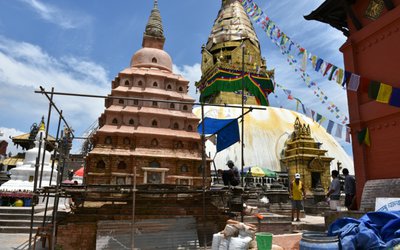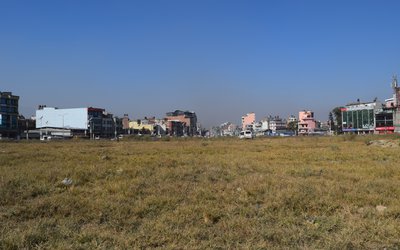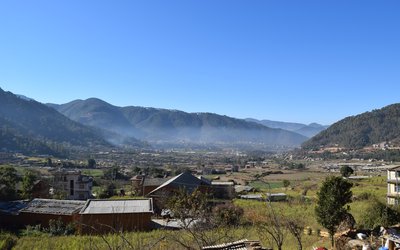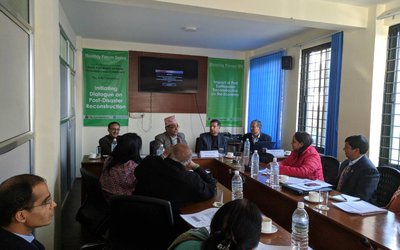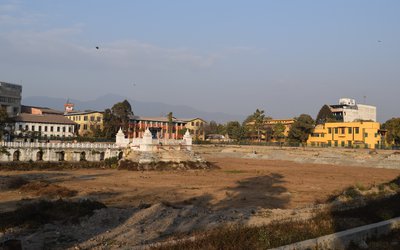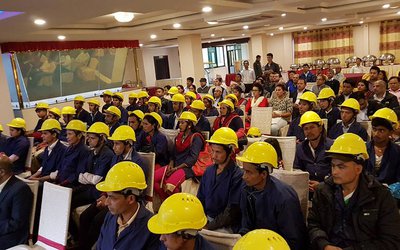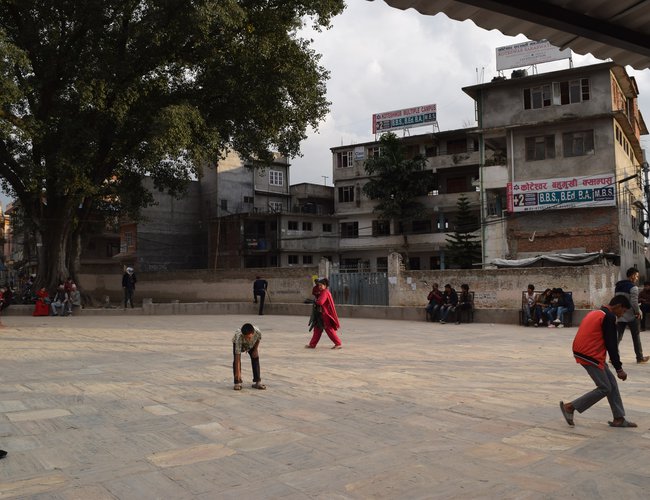
Open spaces and public lands, which sheltered tens of thousands of people during the earthquakes of April and May 2015, are disappearing. With legal ambiguity on the ownership of land and weak regulatory authority, open public spaces are becoming a free for all. These lands are encroached by schools, local bodies, political leaders, communities, government agencies and individuals alike. There is an all-out march from all sectors to capture the public land or open space and use it for commercial purposes. If the current pace continues, with the backing from political leaders, there will be no secured public places left in the next decade in case of another earthquake
Although there were several urgent issues to address, the newly elected representatives of Kathmandu Metropolitan City (KMC) started their tenure, transferring the then Executive Officer, Ishwor Raj Poudel. The reason behind his transfer was reported to be about his push for constructing the park in Tinkune.
When Executive Officer Poudel declined to discontinue the construction work, newly elected mayor of KMC and chair of Ward-32 ordered his transfer.
“Poudel was transferred when the interest of politicians collided with his work. He firmly stood in favor of continuing the construction whereas the elected ward chair and mayor were opposed to this,” said a senior municipal official on condition of anonymity.
During Poudel’s tenure, Kathmandu Metropolitan City invested over 10 million rupees to develop the land of Tinkune as an open park. After his transfer, the construction work has stopped indefinitely. 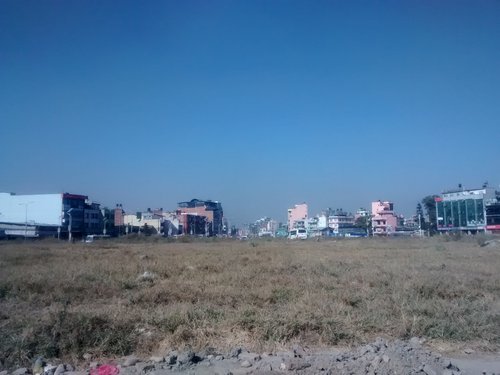
The land is under bushes, while efforts are being made by some individual owners to control it. In the present market rates, the price of 342.25 square units, equivalent to one ana of land, is Rs.15 million. That makes the total price of land to go over five billion rupees in the current prices. Although more than three-fourths of the landowners have received the compensation decades ago, a few landowners have been manipulating the issue politically, legally and administratively to grab the valuable land and sell it for hefty prices.
For decades, the people used the land as an open space, playing football, cricket and for other recreational activities. The recent order of the elected members of KMC has changed everything and nobody knows what will be the fate of Tinkune in the future.
According to the government records, a majority of the landowners have already taken the compensation. A few landowners went to the Supreme Court seeking a cancellation of the order of land acquisition by the government. However, the court declined to issue any such order.
With the skyrocketing prices of land, many interest groups are backing the few from behind to get the benefits as the landowners are ready to pay them anything. The middlemen are active to connect the landowners, land mafia, politicians, and bureaucrats.
“We have just stopped the work temporarily. We will develop the Tinkune land after the settlement of the compensation issue with the landholders,” told Mayor of KMC Bidya Sunder Shakya at a press conference. The decision of the newly-elected mayor of KMC to dismantle Baghdurbar and build a new building there has also landed in controversy.”
With the lack of information about the decision, the public has remained a silent spectator -- there was no resistance or complaint against the KMC over the decision.
This is not the first and only case, where even the elected representatives have stood against the public land and open space. With so many flaws in the Land Act and weak regulatory authority, Nepal’s open spaces and public lands are gradually disappearing, some seeing their ownership transferred to individuals, government corporations, communities, and schools.
As the prices of land soar in urban areas like Kathmandu, the land mafias have been registering many open spaces and public lands individually. With many legal ambiguities and loopholes in the land act, anyone might claim the ownership of the public land. If the present trend of encroaching public land continues, most of the open spaces in urban areas like Kathmandu are likely to vanish soon.
With the population of over 6 million, the demand for land is growing and private land is inadequate to meet the demand, hence, the public lands and open spaces are naturally a target.
“There are two kinds of land mafia in Nepal. One group is claiming the legal rights to the land of Bhaktapur, showing the land documents of Swayambbhu and others are in search of the open and public lands to register. Since Land Revenue Office does not have proper documentation, the officials can hand over the ownership of land to anyone who comes with any document,” said senior advocate Badri Bahadur Karki. “Nepal’s land system has flaws.”
For centuries, the practice has been to leave the public land for social and religious ceremonies or for the times of natural disaster. In all major earthquakes, the people rush to the open spaces and public land till normalcy returns. In the last earthquakes, more than half of the population spent days and nights in the open spaces.
“The earthquake of 2015 showed that an essential part of earthquake preparedness is ensuring safe and accessible open spaces, which are available for emergency responses. With the high rate of urban development in the Kathmandu Valley, open spaces are gradually decreasing. A concerted effort by the government and community groups is needed to preserve the remaining open spaces in the valley,” said Surya Bhakta Sangachhe, Senior Technical Advisor, National Society for Earthquake Technology-Nepal (NSET). “With the support from Department of Urban Development and Kathmandu Valley Development Authority, NSET had also published the inventory of open spaces in the form of an Atlas just five months before the earthquake,” Said Sagachhe. “As per our objective, the atlas helped authorities during the earthquake to prepare an emergency response plans and to help preserve the public open space.”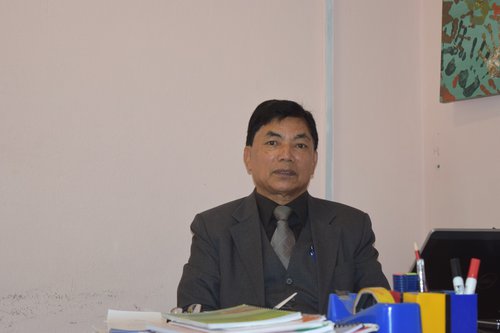
According to NSET Atlas, there are 488 open and public lands, which can be used during the earthquake. Under this study, Ministry of Home Affairs declared 83 places in Kathmandu Valley as open spaces in January 2015. The ministry also accepted the fact that these places were inadequate to provide the shelter and there was the need to have more spaces to cope with future earthquakes.
Published by the Ministry of Home Affairs, Disaster Management Division, the book, Gorkha Earthquake 2015, Experiences, and Learning pointed out that during the last earthquake all the earthquake affected urban centers faced the shortage of open spaces. The report recommended taking immediate actions to protect and preserve open and public spaces of urban centers. It has recommended the government should suspend the process of transferring and handing over open space and public land to institutions or individuals for any purposes and suggested measures to preserve the open spaces such as by erecting boundary walls.
Despite strong recommendations of Ministry of Home Affairs, the encroachment of public land or open space by individuals, government organizations and community organizations continues.
Take another case of the open space of Koteshwor Mahadhevsthan, Ward No 32 of Kathmandu Metropolitan City. It shows how different institutions grab the public land. Four institutions, including Sarashwati Higher Secondary School, community groups and Kathmandu Upatyaka Khanepani Limited, a government-owned entity, have encroached almost two-thirds of the open space. KUKL grabbed part of the open space to build a drinking water filter and a local community erected a two-story building after 2015 earthquake.
“When I was young, there were almost 15 ropanies (83040 square) of open space in Koteshwor height with green trees. Space was so huge,” said Gopal Basnyat, 75, a local resident. “The school encroached half the land of southern part long before. KUKL and a group of people grabbed a chunk of land in the west just recently. There is a rumor that some individual house owners are expanding their boundary towards the open land. There are less than 5 ropanies (27680 square) of open space now.”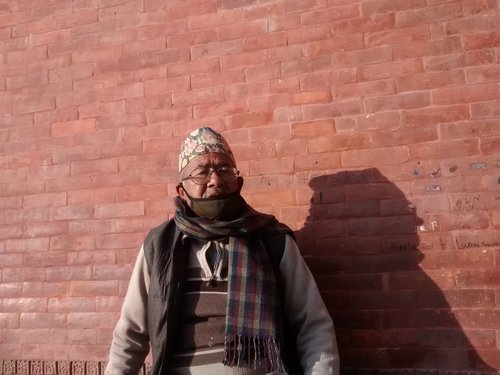
According to the current legal provisions, Ministry of Land Reform is responsible to keep the land records. District Administrative Office is a legal protector and local levels are the guardians of the public land. However, the community is given a very nominal role in the preservation and protection of land.
When three institutions come together, nothing can be impossible. Under the recommendation of local level, any individual can claim the ownership of public or open spaces through land reforms office. Following a formal application and public notice for 35 days, a public land can turn into an individual property.
Although most of the remaining open spaces are under the public land recorded by Ministry of Land Reforms and Management, it does not have the ownership at all. Some open spaces are even under the private and community Guthi land. There are many open spaces owned by nobody but claimed by everybody.
“There is a legal safeguard to protect the public land from illegal registration. One can file complaints at the Commission of Investigation of Abuse of Authority, court and district administration office to nullify any decision of land grabbing,” said Sitaram Dahal, an advocate. “As land mafias are so powerful and politically influential, most of the public lands are registered individually with legal manipulation. Our public lands are safe where the community have a strong attachment, but most of our public lands are vulnerable.”
According to Ministry of Land Reforms and Management, there are massive chunks of public land in all 75 districts and they are enough to develop safe shelters for disasters, including earthquakes. However, only a fraction of the plots of land is transferred to the particular ministry of the government.
“Public lands are well documented by the Land Revenue Office and Survey Offices in all 75 districts. However, it is the duty of District Administration Office and local levels to protect and preserve the public lands,” said Punya Bikram Paudel, information officer of Ministry of Land Reforms and Management. “Without the recommendation of local level, nothing can be possible. If the representatives of local level act cautiously, all the public lands can be protected.”
According to the sections of Kathmandu district Land Revenue Office, Dilli bazaar, Kalanki, Chabahil, Sankhu, they have 22777, 15639, 18315 and 5632 plots of land with over 270303-6-3-1 lakh companies. The annual report of the Ministry indicated that the government is yet to get the records from Manmaiju office. One and of land is equivalent to 342.25 square feet, and one ropani is equivalent to 5476 square feet.
Similarly, Bhaktapur has 5315 plots with 67730-7-1-1 ropanies of land and the government has legal ownership of 63-5-0-0 ropanies of land. In Lalitpur, there are 24234 plots with 263210-3-2-3 ropanies of land. However, there is registration of 2157-0-1-3 ropanies of land.
Ministry of Land Reforms and Management said that there are enormous plots of public land. However, the government is yet to register or transfer them to the different government agencies.
Although there are policies for conservation of national parks, there are no dedicated policies on open spaces. The existing ones are fragmented and included in other policies and regulations.
Promulgated in 1965, the Land Act still governs the land system of Nepal. Although three political systems have changed with four constitutions, this land act has not been reformed. With so many loopholes, the act’s provisions are inadequate to protect the public lands.
“All the public land is owned by the government but there is the need to legally register it. For an individual, he/she can claim any public land through presenting documents and evidence,” said Madhav Poudyal, chairman of Nepal Law Commission, addressing a program in SAWTEE. “As the community knows the history and owners of the land, they should be given the right to protect and preserve the public land and open space.”
Open Space
According to Land Use Policy 2015, Public Use and Open Space Zone is defined as a place of academic institution, including school, college, vocational education centre, university, security body, health institution, including Health Centre, Health Post, private and community hospital, government office responsible for telecommunication, drinking water, electricity and other energy supply, community building, library, elder's home and house, hut, pati (resting inn/house) constructed for public use and the land covered by thereof. These terms also denote hill, mountain, slope land or snow-covered area, grazing land which is not contained in other classification of this policy.
Many open spaces have already vanished and been reduced in their size and areas due to encroachment by government, community, and people in different periods. Even after the earthquake of 2015 April and May, many public lands and open spaces have already vanished and encroachment of the land under political protections continues. National Urban Development Strategy also stressed the need to have open spaces.
Public Land under Squatters
Squatters are a major threat to public lands and open spaces. Backed by the land mafias, with high political support, a large number of urban migrants are encroaching public land as squatters. The squatters are encroaching the prime pieces of public open lands in all the district headquarters and Kathmandu is no exception.
Kathmandu’s prime pieces of public land are now encroached by squatters, particularly at the river banks, which are at the prime commercial areas.
Used as a vote bank, political leaders encourage squatters to stay in the public land. For decades, the land encroachment by squatters has remained a major problem of Kathmandu. Several high commissions and committees were formed one and after another by the government to settle the case and protect the public land. However, public land is under a constant threat of encroachment from squatters.
With the encroachment of public land intensifying, a team has been recently formed under the chairmanship of Kishore Panthi, chairperson of the High Powered Committee for Integrated Development of Bagmati Civilization. The committee comprises Kathmandu Valley Development Authority, UN Park Development Committee and related stakeholders as members.
The team has already begun data collection from the settlement in Thapathali just behind Paropakar Maternity and Women’s Hospital.
This squatter settlement is a vote bank of political parties. It is said that Pushpa Kamal Dahal instructed the concerned ministry that the landless people were ‘not to be touched’ until the election is complete.
President of Nepal Landless Democratic Union Party Hukum Bahadur Lama claimed that there are more than 29,000 landless people in Kathmandu Valley in 73 settlements. “Hundreds of people have also been occupying public land in Lalitpur and Bhaktapur for more than four decades,” said Lama.
There were 1,082 out of 8,000 families who had registered as squatters in 2012. There are 73 places in Kathmandu and three places each in Lalitpur and Bhaktapur with squatter settlements.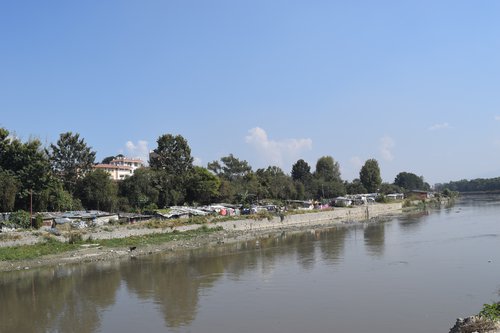
Kathmandu is one of the high-risk city in the world prone to a major earthquake. Current assessments suggest that a magnitude 8.0 earthquake in the Kathmandu Valley would result in a huge loss of life and displacement.
“With over a million persons expected to be displaced in case of a major earthquake, there is the need to strictly maintain open spaces for humanitarian services,” said Kishore Thapa, former secretary of Ministry of Urban Development. “We must work to strictly secure open space and public land. The more open space we keep, the more secure a shelter in open space there will be,” he said in a program organized by SAWTEE.
Following the earthquakes in 2015, the government has taken a number of proactive steps towards risk reduction and preparedness. One of the steps is to protect the open space by mobilizing the local levels.
According to the High Powered Committee for Integrated Development of Bagmati Civilization, many persons, families, and organizations are illegally occupying Bagmati river banks and open spaces.
The board issued a notice in June to Himalayan Institute of Science and Technology Engineering College (Sinamangal) and Glacier International College, VS Niketan, Pentagon College, some monasteries, private institutions and households with 35 days to vacate the public space and stop encroachment on the river banks.
According to the committee, VS Niketan at Minbhawan, Pentagon College, and some monasteries have already vacated the river banks, but HIST and GIC, including other private institutions, are yet to abide by the order.
Some buildings still stand and are operating within 20 meters from either bank of the river. Under a coordination with police, army, political cadres and local activists, HPCIDBC piled pressure on the institutions to clear away from the land that falls 20 meters on either side of the Bagmati.
“The government has prohibited the construction of any structure within 20 meters on either side of the bank of the Bagmati River, but illegally built structures have been dotting the area.”
There are more than 4,000 illegal structures standing along the open space of river banks between Gokarna and Chobhar. More than 150 ropanis of land along either side within 20 meters of the river banks are still dotted with illegal settlements. However, HPCIDBC has so far managed to claim only 40 ropanis of land.
Government’s Priority
After the earthquake, identification, allocation, and planning of open spaces have been a priority. Open spaces refer to the areas in Kathmandu Valley with a free space that can be used for the humanitarian response (camps for displaced persons, logistics centers, distribution centers, security and incoming military coordination sites.)
“Identification and protection of open spaces in earthquake-prone cities such as Kathmandu Valley are necessary for effective and coordinated response, saving lives and assisting recovery,” said Thapa.
According to experts, open spaces are particularly important in regard to logistics which will be one of the major challenges.
In its commitment to risk reduction and preparedness, Nepal government approved and secured 83 open spaces in the Kathmandu Valley; that equals nearly 4,000,000 sq.m of land in 2013. However, this piece of land is too little in the case of another earthquake.
Published by National Society for Earthquake Technology Nepal, in partnership with Kathmandu Valley Town Planning Authority and Ministry of Urban Development, the Atlas of Open Spaces in Kathmandu Valley inventories and documents all these open spaces. Although made four years ago, it is one of the comprehensive and well-documented Atlases of open space.
Why Open Space?
Declared in 2013, the earthquakes of 2015 have shown that the 83 open spaces in Kathmandu were not enough to handle the expected number of displaced persons from an earthquake.
Once people started to come to roads and other spaces, each and every open space, became invaluable after the earthquake.
Just declaring the open space is not a guarantee of the place as safe for shelter, there is the need to have plans on how each open space will be used. In its broader mandate to make Nepal safe from earthquakes in future, National Reconstruction Authority is also issuing guidelines for the concerned ministries to protect the open public lands.
“NRA is working to protect and preserve the public land and open space for future disasters. We are discussing the matter with all the concerned ministries,” said Yam Lal Bhoosal, spokesperson of NRA.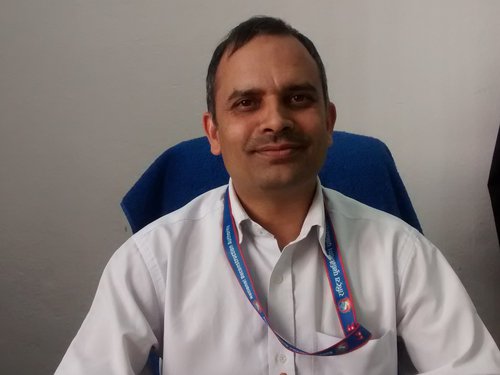
KMC Plan
Although the newly-elected representatives of KMC failed to protect the open spaces, there is a good plan prepared by the nominated employees to create more open spaces for the safety of people during disasters.
In order to create additional open spaces, the KMC has planned to procure privately owned buildings and land in city’s core areas. Likewise, the land possessed by the government and semi-government institutions in city’s core areas will be procured to expand the open spaces.
KMC ordered that the government and public will not be allowed to construct physical infrastructure in open spaces owned by KMC. But they can assist in developing green open spaces.
With the elected representatives at the helm, KMC is now more interested to use open spaces for commercial use rather than public interest during the disaster.
KMC also publicly announced that the business projects would not be allowed on empty land owned by the government, social, educational and public institutions within the premises of metropolis. But empty spaces must be converted into green open spaces, recreational parks and gardens in all 35 wards of Kathmandu through legal processes and scientific approach.
Now, KMC elected representatives are selling the idea of building commercial buildings in public and open spaces to seek rent. Its decision to dismantle spacious Bagh Durbar is now in controversy.
Master Plan for Open Space
Presenting the first budget after the earthquake, then finance minister Dr. Ram Sharan Mahat announced that it would arrange one open space for every 25,000 population in the Kathmandu Valley. The government announced infrastructure development at vacant places for post-disaster preparedness.
The government had tasked Kathmandu Valley Development Authority with the responsibility of protecting and managing identified open spaces for use in the aftermath of natural disasters. “We don’t have any legal mandate to protect the public space,” said Bhaikaji Tiwari, chairperson of Kathmandu Valley Town Planning Authority.
The government had designated 83 open spaces for effective humanitarian coordination and response to mega natural disasters, especially earthquakes, while the KDVA has identified 887 more open spaces, including government, public and private lands and forested areas in the Valley. Of the identified open spaces, Kathmandu has 488, Lalitpur 346 and Bhaktapur 53.
Despite the government efforts to prevent encroachment of identified open spaces in coordination with local people and managing and protecting such places, nothing has changed as many people are still occupying open spaces.
The Open Air Theatre is being turned into an underground parking lot. Over the years, Kathmandu’s dwindling open spaces are being increasingly encroached upon.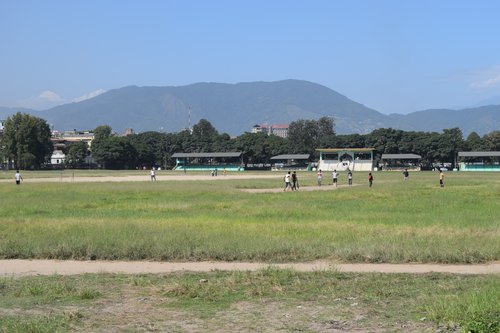
“Post-earthquake period was the right time to plan and make people understand the value of public spaces, but unfortunately it is not going in that direction,” said Padma Sundar Joshi of UN-Habitat.
Community Protection
Despite the efforts and decision of the government, there are only a few open spaces turned into public parks at present. At a time when the open space under the government and municipalities is vanishing, the local communities have shown a way to maintain it. Nandi Keshwor Garden in Naxal and Bankali Garden in Pashupati area two examples.
Experts have already warned that Nepal will face a severe humanitarian crisis in future disasters, such as earthquakes, when people require open spaces to build their temporary shelters.
“If Nepal faced earthquakes of strength similar to those of 2015 or more, heavy damage is likely and people will feel the need of more open space for the temporary shelters. However, the open spaces are vanishing very fast and, therefore, Nepal can face a severe humanitarian crisis in the future,” said Sangachhe.
With the combined efforts of local bodies, individuals, survey, and land ownership offices, any public land can be transferred to persons. With a very nominal role given to the community, the recommendation of local bodies is enough to claim the ownership of the public land.
Trends of encroachment over arable lands, forests, government and public lands, various natural resources are being exploited in a rampant way these days because of a fast-growing population, internal migration, unmanaged and rapid development.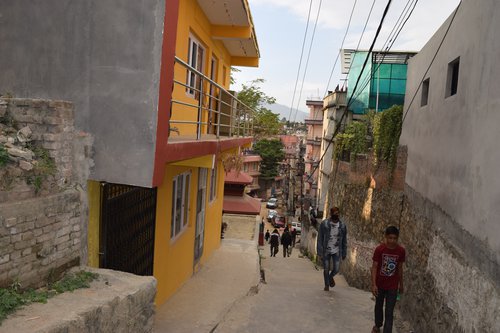
Given the recent decisions of KMC, including the decision to stop the construction in Tinkune and demolish an old durbar, it is likely that most of the open spaces and public lands are likely to disappear in the decade ahead. In case major earthquakes in the future, there will be fewer safe and secure places for shelter.
“Mafia Nexus Threat To Open Spaces”
Having worked for a long period in Ministry of Urban Development, Surya Bhakta Sangachhe, an architectural engineer, is an established name. Sangacche, now a technical expert at National Society for Earthquake Technology Nepal, spoke to New Spotlight about the importance of open spaces. Excerpts:
Why are open spaces disappearing in Nepal?
There are several reasons. However, one of the main reasons behind it is that there is no documentation of open spaces. Since the documentation is with Department of Survey and Department of Land Management, their involvement is necessary to register the public land as personal.
With the involvement of employees of survey and land management offices, the land mafias and land brokers are converting the public lands into private properties. This is an open fact.
First of all, there is the need to identify public lands in fields as well as in maps. After the recognition of the types of land, the local community, bordering with the public land, need to inform about the public land and people should be informed of their right to protect and preserve the land as a common property. As long as the government does not hand over the responsibility of public land to the nearby community, people will grab the land, sharing between them. If the government develops a sense of ownership for them, they will protect and preserve it. Recently, people have saved some public spaces on their own from land mafias and converted it to Public Parks.
How do you look at the tendency?
There is a tendency among the land mafias in the country to claim the ownership of the land which is vacant and open. They use every hook and crook to register it. The land brokers are so powerful that they maintain relations with elected representatives, judiciary, bureaucracy and politicians at the top. They use the influence accordingly to grab the land. There is a massive irregularity in the land management related office.
How do you see the level of awareness?
After the earthquakes, the level of public awareness has gone up. People are much aware of the need to protect the public land. People have the knowledge; it is now difficult to encroach the land identified as an open space. However, there are many public lands which are yet to come to public notice and they are at risk of encroachment. It is unfortunate that there is a small portion of land, which is known as open space. There is a much bigger portion of land, the status of which many do not know.
What do you suggest to protect the open land?
There is the need to demarcate all the public lands. Municipalities and rural municipalities have to play an important role to preserve the public open land. If they go to become corrupt, no one can preserve the spaces. Given the escalation of the price of land in urban areas, there is a high possibility of encroachment. Again, handing over the ownership to the community is the best way to preserve the open and public land. The government should have the least of all land, whether it is of the public, guthi, community or someone else. People are encroaching the public land. Everyone is encroaching the public land. During my tenure as head of Kathmandu Town Planning Office, I found a number of people encroaching the river banks of Kathmandu. Individuals whose land is close to river banks always have a higher volume of land.
How much of open space does a country like Nepal require?
It is good to have more open land. However, there is the need to maintain a minimum land for open space. Comparing to the neighboring country, Delhi has 20 percent of its area as open space, and Mumbai 2.5. In Kathmandu, 0.48 percent of open space is there, which is insignificant. Recently, we see the open space is decreasing significantly. Don’t think about the earthquake, we need open space for life. Each individual needs a minimum of 66 square meters of open space. This is necessary for the country. We need open spaces to hold political rallies, festivals, feasts and other social functions.
What is the state of open space now?
When our population was small, there used to be big open spaces and now when our population is almost five million, there are very few open spaces. Some open spaces are occupied by Army, Police or sports units. All the open spaces are occupied by Army, Police, Temples, community houses, schools and municipal ward offices. The remaining open spaces are illegally occupied by squatters in the urban areas. There is a rampant misuse of public and open land. If things go as they are at present, we will lose every open space in the next decade. There is a trend to fill the ponds and make buildings. There is the need of a minimum six square meters of land. This is the regional standard. We need to have 10 to 15 percent of open land. During the earthquake, everyone, whether rich or poor, feels safe while sleeping in the open space. People need open spaces to sleep during the earthquakes. We cannot get a shelter on the road because they are important for evacuation and rescue. Here open space is important. We have identified 888 sites which need to be protected and preserved.
" Political Will Must To Save Open Spaces"
Punya Bikram Poudel, information office of Ministry of Land Reforms and Management spoke about the role of government to protect and preserve the open spaces and public lands.
What is the state of public land?
Nepal government does not have accumulated data on public land. We are collecting the data and updating it. The District Survey Office maintains the field book of the land and District Offices of Land Reforms and Management keep the records of all the land, including public land, private land, Guthi land and so on. District Land Reforms and Management offices are responsible to decide the owners of land and issue the landowner rights.
How does the Ministry interpret the open land and public land?
All the open spaces are not the public land. Most of the open spaces are on public land. Open spaces are also owned by temples, Guthi, community, and individuals. In our case, ninety percent of open spaces are on public land.
Public lands and open spaces are vanishing because the land ownership is now gradually being handed over to individuals by your department illegally. How do you look at this?
The role of our ministry is to keep the land records and issue certificates of the land under the recommendation of local levels. Legally, Home Ministry is responsible to protect open spaces and public lands and it is the duty of local levels to preserve such lands. Without the recommendation of local levels, Land Reforms and Management Office cannot issue certificates. Our offices establish the right over the land on the recommendation of local levels.
Doesn’t your ministry take any responsibility in the vanishing of the open spaces and public lands?
Our offices can suspend the transactions of land and keep records. There are other ministries also involved in the protection of land. Ministry of Urban Development is responsible for settlement, Ministry of Home Affairs for legal protection and local level for preservation or guardianship.
How can we protect the open spaces and public lands?
As I have already told you that local levels have the legal rights to recommend in deciding the types of land. Even District Administration Office cannot do anything without the support from the Local Level. In one word, public land and open space can be protected if the leaders show political will and commitment. Once politicians can show will, our public land will be secure and safe
"Community Can Save Open Spaces"
Having specialized in land issue, advocate Sitaram Dahal holds the view that there are ways to stop the process of registering public land and open space.
How do you see the state of the encroachment of public land and open space?
With no real owner, Nepal’s open space and public land are vulnerable to encroachment. Our land is divided into several categories. Some lands are under the public trust (Guthi), Public Trust, Public, and Private. Since private land has owners, they defend it. In the case of land owned by Public Trust, it is managed by Guthi Sansthan. The land owned by Private Trust is often in controversy when it comes to its transaction. However, the public land and open spaces have no owners and ownership of this land and it can easily be transferred in the name of individuals.
Is there any legal way to prevent the transfer of ownership of open space and public land?
Our laws have made certain provisions for its protection. Under a complaint filed by local people, chief district officer, Commission of Investigation of Abuse of Authority can take legal actions against such individuals. Supreme Court of Nepal has several orders against converting the public land into private property. In most of the cases, ownership of public lands is converted to the private with the involvement of local political leader, local level leaders, officials of district land offices and land mafias.
How do you suggest protecting the public land?
The community should be made responsible for the protection and preservation of public land. If they feel their ownership of public land, they will defend it. In many places, squatters and mafia drop their idea when they see organized protests from the community. The open space and public lands transferred to Municipality, community schools and community health posts are highly misused nowadays. By issuing tenders to demolish Bag Durbar and turning the open theater into a bus stand for commercial use Kathmandu Metropolitan City has shown how local level can misuse such places.
"Open Spaces Are Safe Shelter"
Spokesperson of National Reconstruction Authority Yam Lal Bhoosal holds the view that NRA is in favor of preserving the open space for safer shelter in the disaster.
How does NRA take the vanishing of the open spaces?
National Reconstruction Authority (NRA) is very much concerned about it. As a body formed to carry out post-earthquake reconstruction and rehabilitation work, NRA is also promoting safer city and settlement. Open spaces are one of the major components of a safe and secure city.
What step has NRA taken then?
The executive committee meeting of NRA took a decision a few months back requesting all relevant stakeholders, Ministry of Home Affairs, Ministry of Federal Affairs and Local Development, Ministry of Tourism and Civil Aviation, Ministry of Urban Development and Ministry of Land Reform and Management not to permit any new construction. NRA also requested them to preserve the open spaces so that they can be used in future.
"Open Spaces Are Lifelines"
Gopal Basnet, 72, a local resident of KMC, Ward 32, Koteshwor, holds the view that the government needs to demolish the structures built in open spaces.
How do you see the importance of open spaces?
Open spaces are our lifelines. When I was young, there were several open spaces in our area. What I can see now is that most of these spaces are nowhere.
What is the state of Koteshwor open space?
The open ground of Koteshwor is now squeezed into a small patch of land from the 15 ropanies of a big and open plot of the past.
Who encroached the land?
Ask who did not encroach the land. The school occupied half of the land from long before and local residents bordering on the open space also use part of the land as their personal property. Even after the earthquake of 2015, Kathmandu Upatyaka Khanepani Ltd and local community encroached the land and built water filter and house.
Why does the public not oppose it?
Although we spent our time in open space and used it during the earthquake, no one feels the land is owned by them. This is the reason nobody has the sense of ownership. Most of the residents of the area are outsiders and they don’t have the feeling of love for the soil.
New Spotlight Investigation November 10-23.pdf
This publication has been supported by The Asia Foundation. The contents of this publication reflect the views of the author(s), researcher(s), and contributing editor(s) and do not necessarily reflect the views of The Asia Foundation.

Open Space of Koteshwor
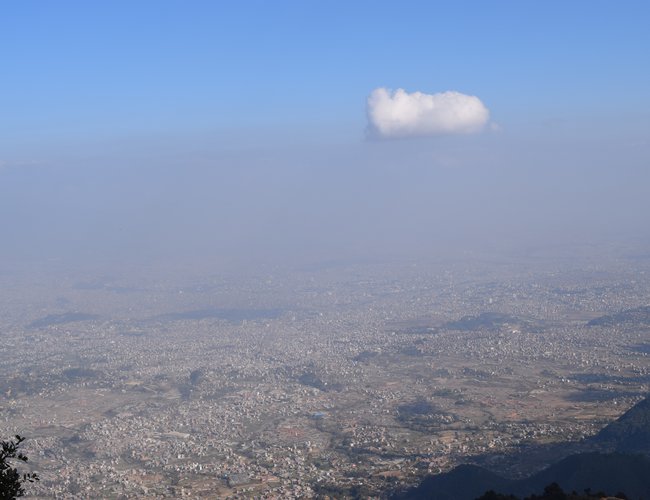
Aerial Photo Kathmandu Valley's open spaces are vanishing

Keshab Poudel
Poudel is the editor of New Spotlight Magazine.
- IWMI: SoLAR Global Science-Policy Forum Conference
- Apr 25, 2024
- CLA: Samriddhi For Skill Development
- Apr 23, 2024
- ECONOMY: Growth At 3.3
- Apr 16, 2024
- DPM’s SHRESTHA’S CHINA VISIT High Profile, Low Key
- Apr 14, 2024
- Maha Kumbha In Barahkshetra: A Sacred Festival In Sacred Koshi (Kaushiki) River
- Apr 09, 2024

